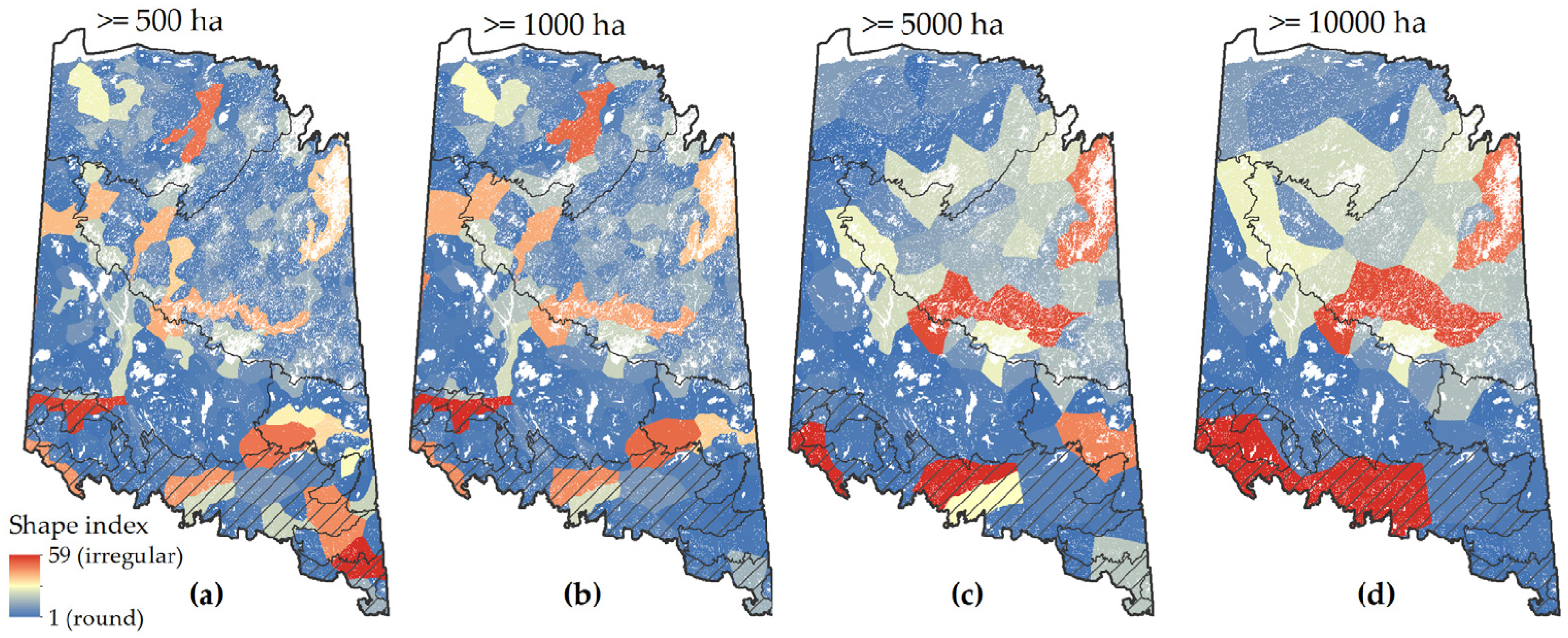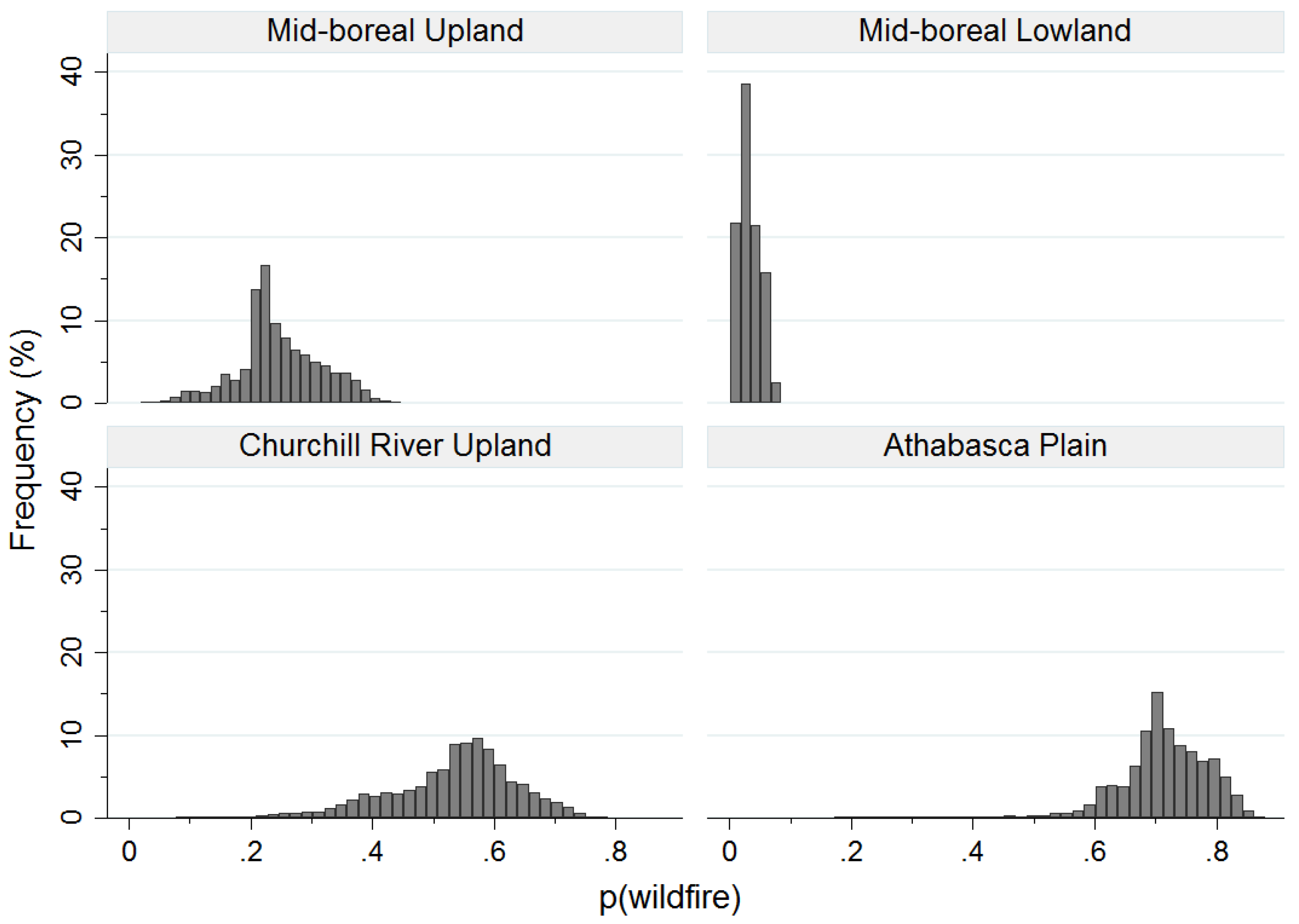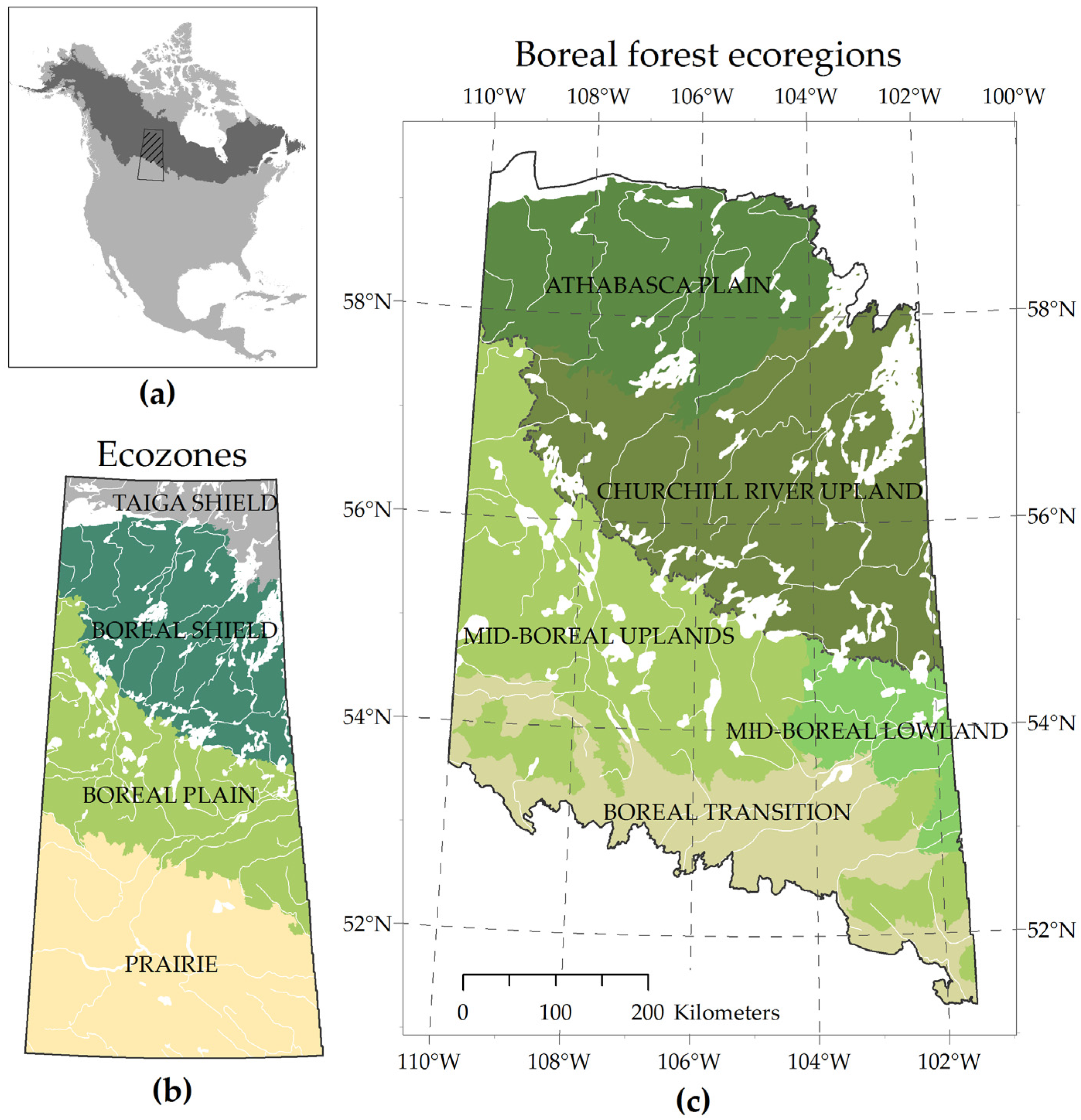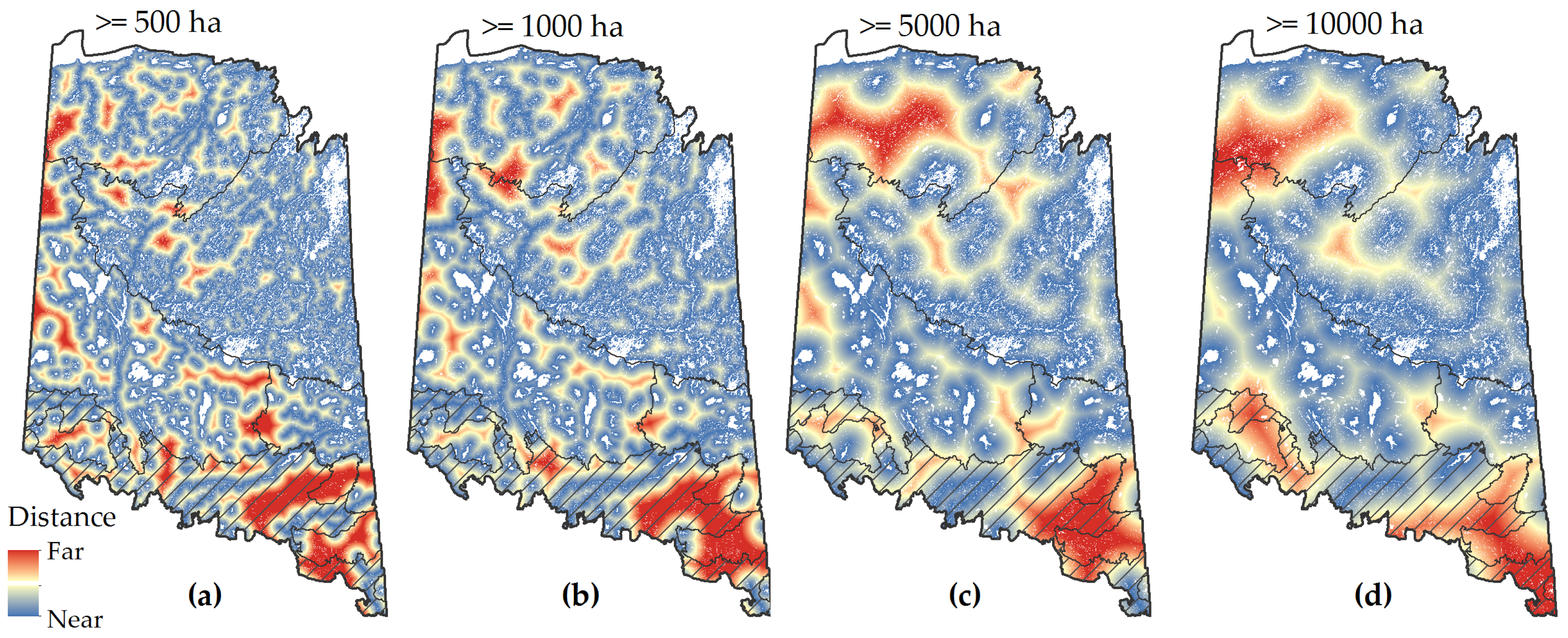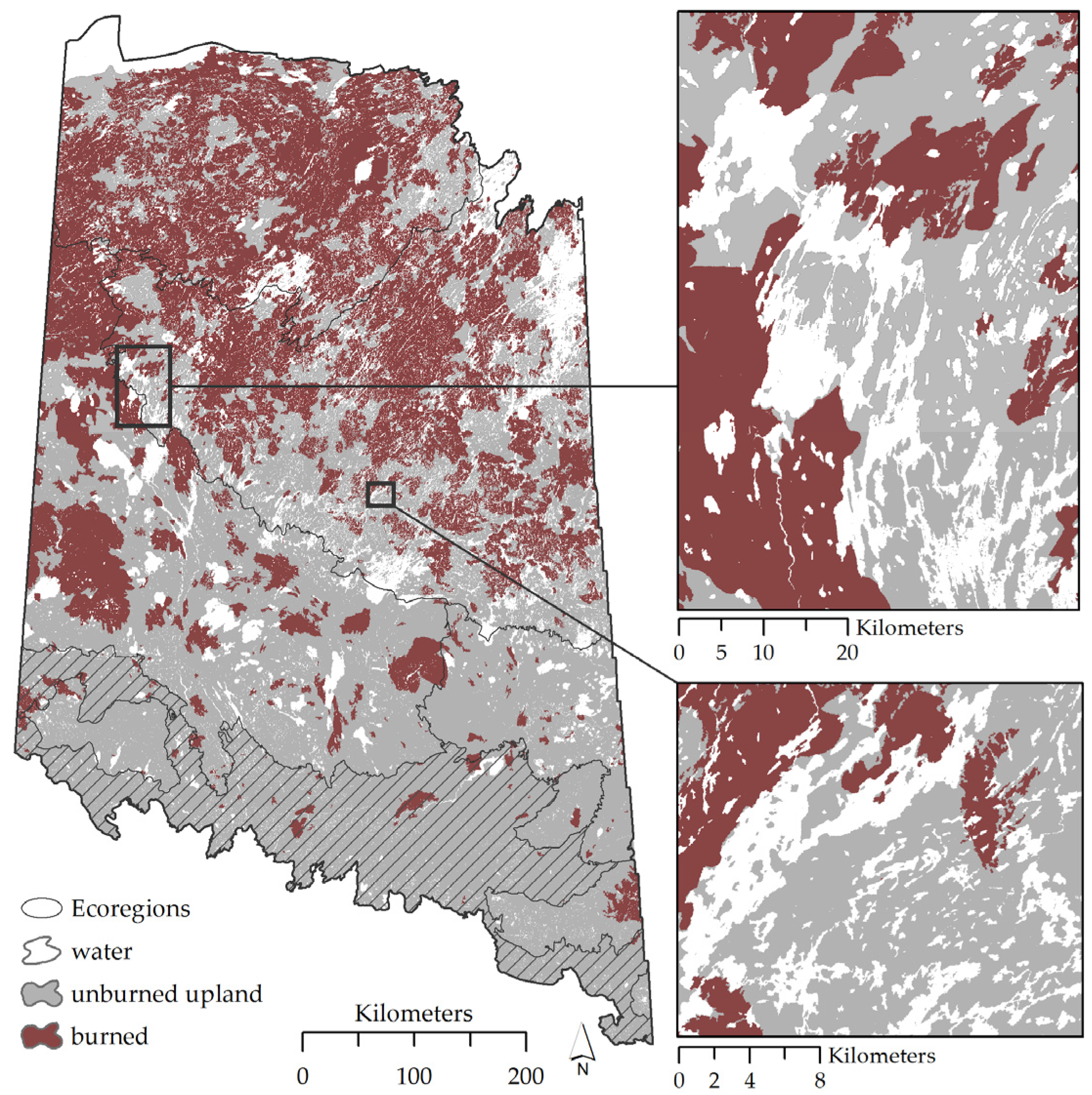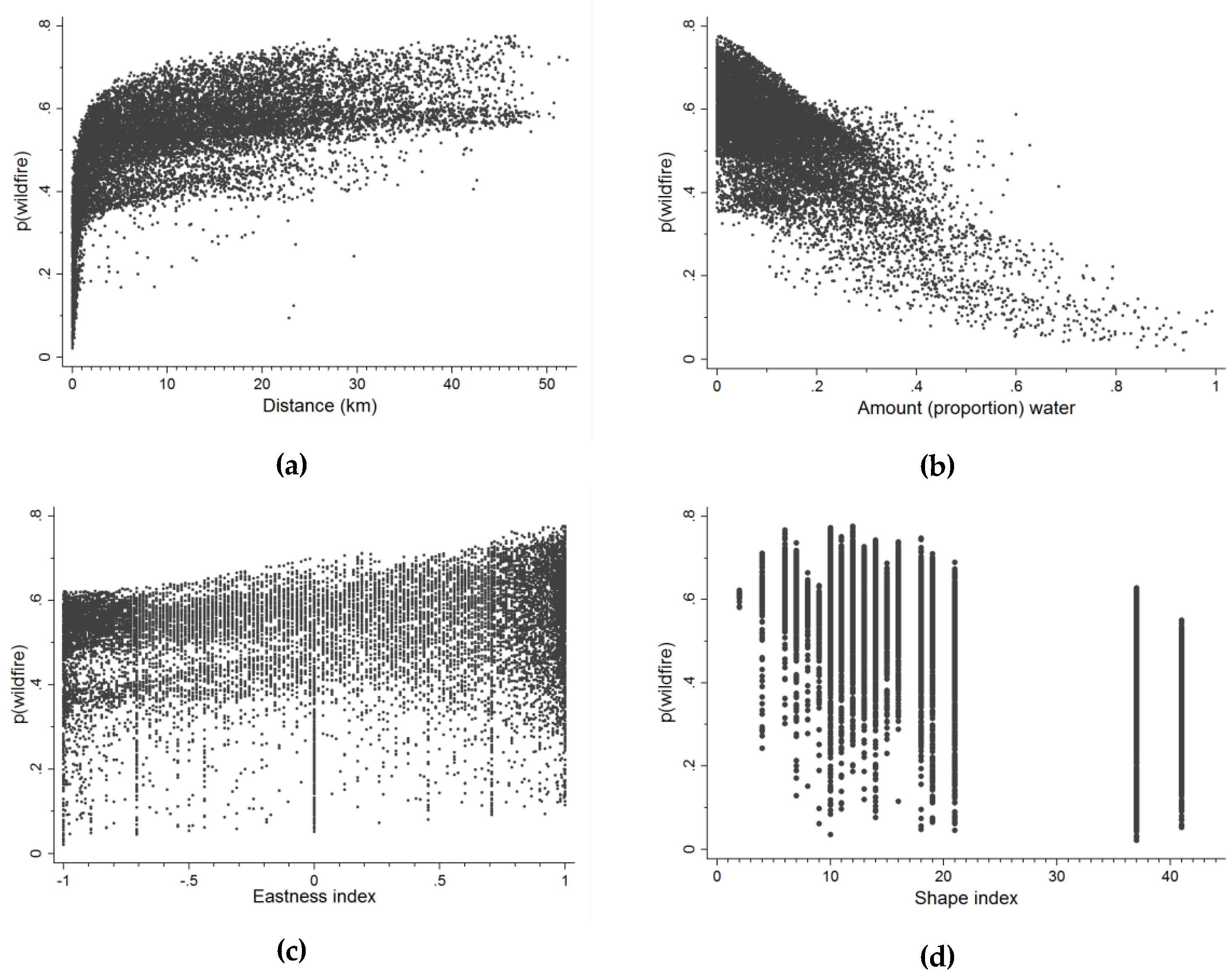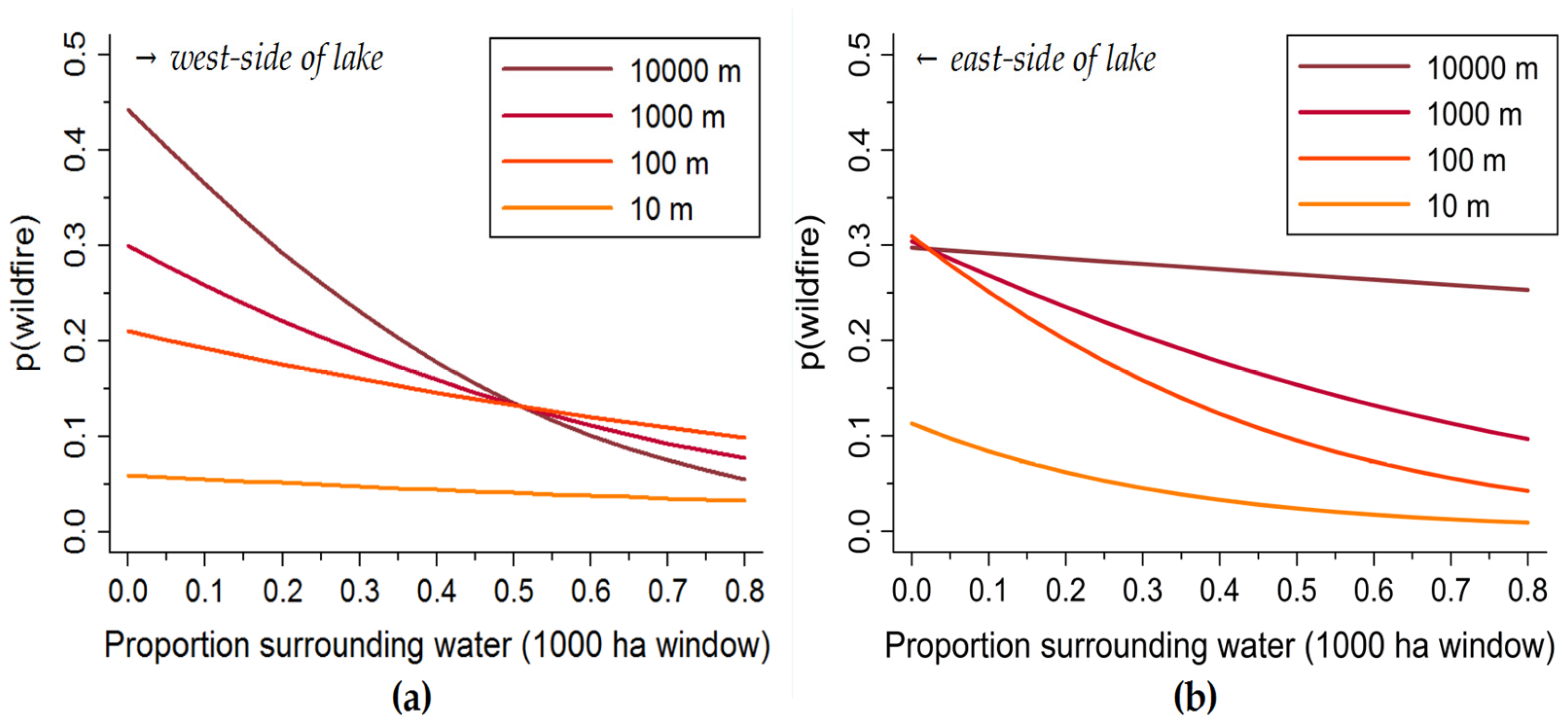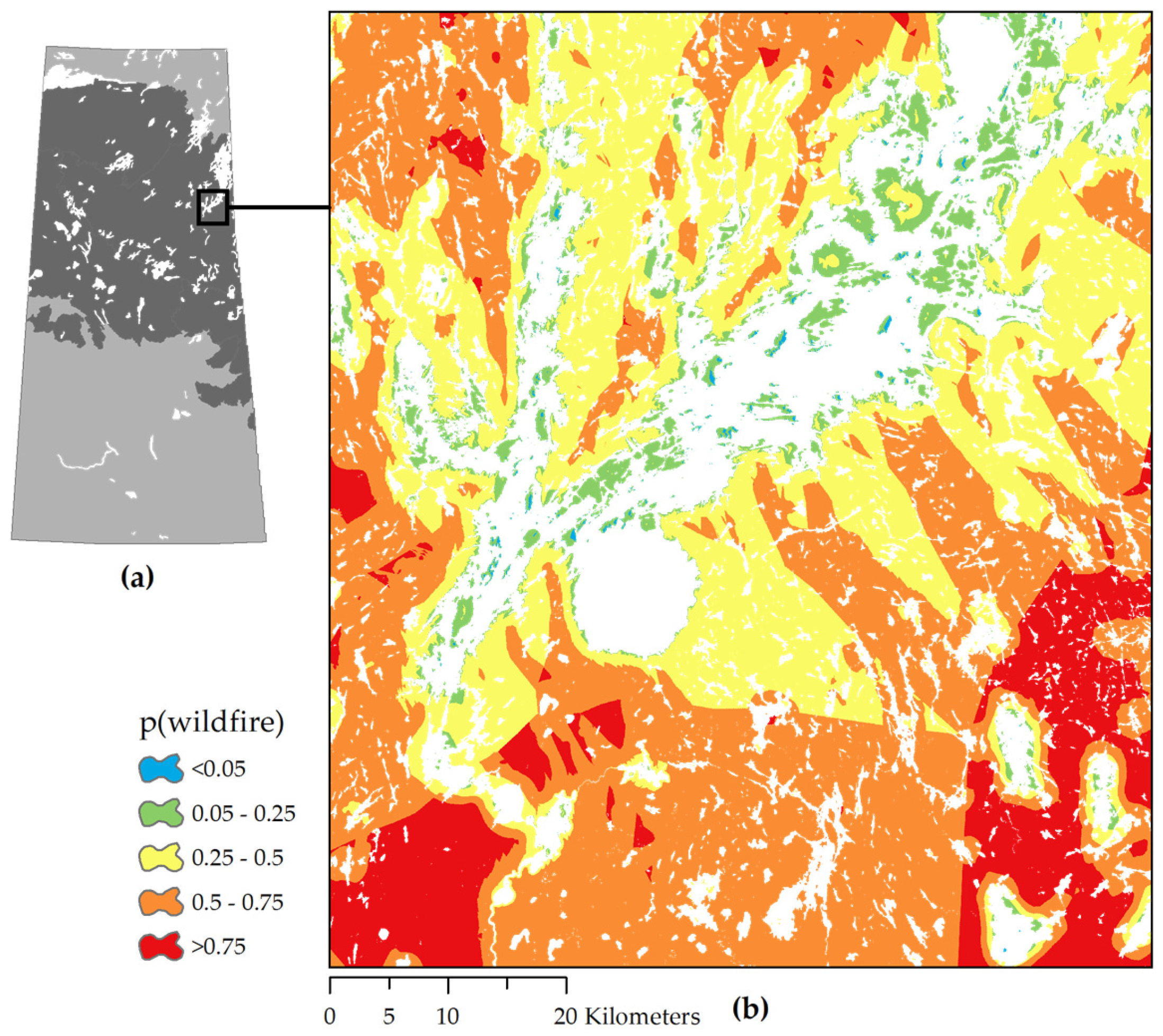1. Introduction
Boreal forests are shaped by wildfires that are affected by spatial and temporal factors that influence both individual fire characteristics (e.g., size, shape, severity) and more generally the local landscape’s fire cycle [
1,
2]. Although temporal factors affect when a fire occurs, its intensity (energy release), and its severity (ecological impacts), the landscape structure and physiography influence where fires are more likely to burn, and thus the spatial pattern of the forest mosaic [
3,
4,
5,
6]. More complex landscapes have more heterogeneous patterns in vegetation, which results in more complicated fire patterns [
4,
7]. One element of a landscape’s physiography that is particularly important in the boreal forest is the amount and location of water bodies, since these features can act as natural firebreaks and thus barriers to fire spread [
8,
9,
10].
There are a number of different landscape characteristics of water bodies that may affect the adjacent upland’s fire patterns and local fire cycles, including the size, shape, and orientation of water bodies [
11]. Large lakes are especially important in stopping the spread of fires, whereas smaller water bodies (or other natural firebreaks) may stop the spread of smaller fires and those fires perpendicular to the dominant wind direction [
12]. In the boreal and hemi-boreal forest of central Canada where winds are dominantly from the west, forest stands on the eastern sides of larger lakes often have longer fire cycles [
11]. Indeed, in some places, old-growth forests may be much more common on the eastern shore of large lakes and on islands within the lake [
8,
11,
13]. Likewise, fire-intolerant tree species, such as white cedar (
Thuja occidentalis L.) that are uncommon in upland forest locations away from lakes, are often associated with the downwind stretches of lake shorelines [
14]. Although white cedar is most often considered a wet-adapted species given where it most often grows, it is also known to occur in the most extreme dry conditions along bedrock ridges and cliffs where fires are limited [
15], thus suggesting that some combination of fire and moisture limits its distribution, and not solely water availability [
16]. Landscape patterns of lakes may therefore not only influence distribution of where fires occur and thus associated patterns in forest age, but also forest composition.
Although it is well acknowledged that natural firebreaks such as lakes, a common feature of the boreal biome, exert a strong (if localized) bottom-up control on boreal wildfires, the mechanisms by which this occurs requires further examination. For instance, the “edge effect” of lakes, whereby wildfires are less likely closer to the edge of large lakes, has been described previously by others [
9,
14,
17], but it is still unclear how this is affected by lake size, lake shape, and orientation (bearing) around lakes. Given that both landscape patterns and prevailing winds are non-random [
12], the effect of lake proximity on wildfires should be dependent on and interacting with other factors. Similar to individual lake size, the overall proportion of natural firebreaks (including lakes) has been shown to affect wildfire activity in the boreal forest of Sweden [
18]. This concept of vegetation fragmentation is in fact one of the principles guiding landscape fuel reduction [
19]. However, simulation studies suggest that there is more to the “more nonfuel equates to fewer fires” concept, as the effectiveness of firebreaks is also a function of landscape configuration and fire regime characteristics (e.g., fire size, ignition patterns) [
20]. A better understanding of the effects of large lakes on boreal wildfire activity thus implies the need to capture both primary effects of adjacent lake characteristics (e.g., proximity, proportion) and the synergistic effects of factors describing configuration and orientation.
The objective of this paper is to examine the landscape effects of lake size, lake shape, amount of surrounding water, presence of islands, and the distance and direction to lakes on wildfire patterns in the boreal forest of Saskatchewan, Canada. Specifically, we examine how the distance to different sized lakes interacts with direction to lakes, shape of lakes, and amount of surrounding water to influence wildfire patterns, thus helping to identify the conditions where old-growth forests are most likely within a fire-prone forested ecosystem. We did this by examining a 35-year history (1980–2014) of wildfires in northern Saskatchewan’s boreal forest where fire perimeters have been mapped using aerial imagery and compared this information with landscape measures of water.
4. Discussion
The results of this study support the idea that spatial patterns, and more specifically the local likelihood, of wildfires are not uniformly distributed within the boreal forest. Natural firebreaks, particularly large lakes, represent a strong bottom-up control on wildfire activity. Despite the stochastic nature of wildfire, all of the hypothesized landscape measures of water affected wildfire patterns. This includes the amount of water, the distance to large lakes, the direction to large lakes, the shape of the lake and, finally, insularity. Although the primary effect of these individual factors has been documented in different biomes of the world, we show here that they interact amongst themselves to yield highly heterogeneous patterns of wildfire likelihood.
Perhaps the most common measure of assessing the effect of natural firebreaks on wildfire occurrence is the distance of wildfire from those breaks. When fires burn less frequently near lakes, “fire shadow” patterns develop [
14]. Our results are in agreement with those reported elsewhere in the Canadian boreal forest that the effect of large lakes may extend several kilometers beyond the edge of the lakes and wetlands [
9,
10]. The most pronounced effects of lakes are, however, within the first 100 m of the lakeshore [
17]. Our results suggest a 3.5-fold increase in risk of wildfire between 10 and 100 m lake distances. The increase in wildfire risk with distance from lakes stabilized at ~2.5 km, which is similar to that reported elsewhere [
30].
Amount of open water in the surrounding landscape also influenced wildfire patterns. In northern Saskatchewan’s boreal forest, the amount of surrounding water appears to be as important to wildfire distribution as proximity to lakes. These results are similar to those in boreal Sweden, where mean fire intervals were correlated to wetland density, provided that these wetlands were moist enough to limit fire ignition and spread [
18]. Given the strength of this control, fragmented landscapes simply do not burn as well as those with highly continuous fuels. Indeed, the proportion of natural firebreaks is often identified as a key variable explaining broad-scale wildfire patterns in the boreal forests of Canada [
31,
32]. The specific mechanism by which reductions in wildfire frequency occurs is, however, complex. Not only are lakes (and other non-fuels) limiting the potential spread of large wildfires, but they also eliminate possible sources of ignition. Fire shadows therefore develop from both a lack of ignition in lakes and the impossibility of a fire growing out of the nonfuel [
33].
To provide a more comprehensive assessment of the effects of large lakes on boreal wildfire activity, this study incorporated a number of known or suspected factors that affect fire ignition and spread. For instance, our results support others who demonstrate that orientation of landscape features may impede or promote (e.g., river valleys parallel to dominant winds) the spread of large wildfires [
12]. Although this remains to be fully investigated in the boreal forest, the orientation of natural firebreaks may not just affect the frequency of wildfires, but also the type. For instance, crown fires may wrap around firebreaks and burn as less-intense surface fires [
34]. The shape of firebreaks, including lakes, is also important [
35]. We found that more irregular-shaped lakes reduce wildfire activity in Saskatchewan, but that the effect of this factor is highly dependent on other factors, notably size and orientation to nearest large lake. For example, elongated features perpendicular to an incoming fire may provide a more effective fuel break than a round-shaped lake [
12]. However, if the lake is too narrow wildfires may simply breach (i.e., through fire spotting) the firebreak.
Interactions among factors further highlight the complexity of the relationship between wildfire patterns and natural firebreaks. Interestingly, the top-two most supported interactions in our analysis (amount × direction and distance × direction) include the orientation relative to the lake, which emphasizes the importance of the direction of incoming fires in identifying and predicting potential fire refugia. Whereas our results point to important multiplicative effects between variables, the interpretation of these interactions is not straightforward. For instance, predicted patterns of wildfire probability on the east side of large lakes were less related to distance to lake when amount of surrounding water was low. This could be interpreted as a higher-level interaction among factors. Given the high density of large lakes in the region, the effect of a given lake on wildfire patterns is assuredly influenced by that of nearby lakes. Likewise, we found evidence for three-way interactions that support the idea that there is a high degree of complexity in the fire–environment relationship, which in turn leads to complex landscape patterns [
36].
Whereas the likelihood of wildfire occurrence is highly dependent of transient factors, such as forest type [
37] and daily fire weather [
38], our results highlight the effects of quasi-permanent landscape features that can reduce wildfire likelihood for decades or centuries. Areas close to large or numerous lakes are simply more likely to lead to long-term fire refugia, which can be defined as parts of the landscape where intense crown fires are rare. These areas are therefore likely to support old-growth components that are not common elsewhere in the landscape [
39]. Fire refugia have a potentially important—though still poorly understood—role in the maintenance of biodiversity and ecological processes in the boreal forest (but see [
40]). In a matrix of high fire frequency, areas of the boreal forest that rarely burn may support isolated populations of organisms not found elsewhere in the landscape. For instance, species ill-adapted to fire, such as balsam fir, have survived on islands of large lakes in northern Québec [
41], while common fire-adapted species, such as jack pine, have been absent from fire-sheltered sites for millennia in northern Wisconsin [
42]. Spatial variability in wildfire occurrence also affects fundamental ecosystem properties [
13] that, in turn, further affect community composition [
43].
Results from this modeling study are contingent on their assumptions and data quality. For instance, some wildfire perimeters do not include unburned islands which would attenuate the strength of the effect of islands on wildfire probability. The somewhat coarse resolution of the fire perimeter mapping will invariably affect the strength of the other relationships, although we do not expect these to be directionally biased in a way that adversely affects our inferences. Likewise, we did not consider non-water related variables that are known to affect wildfires (e.g., land cover, daily fire weather, lightning, topography [
44]). Lack of inclusion of these factors limits the predictive ability of our models, although the five landscape water variables considered here were predictive and largely supported our hypothesized relationships. Of note is the effect of humans, which is pervasive (if not intense) in the boreal plains portion of our study area [
45]. Although large boreal wildfires are virtually uncontrollable and burn more or less “freely” once they escape initial attack, humans may have a subtle yet considerable influence on wildfire activity through direct (igniting or extinguishing fires) or indirect (land-use change) means [
46].

